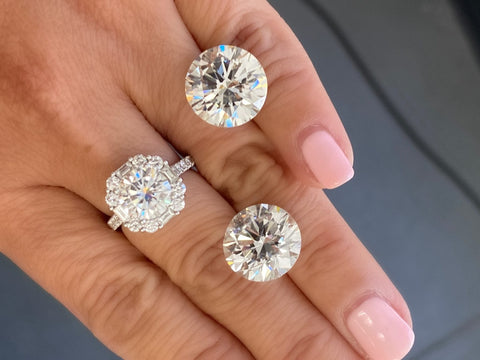What You Must Know When Purchasing Earth Grown Diamonds
I entered the Jewelry industry to make buying fine jewelry easier for the consumer. As we all know, the fine jewelry industry can be ambiguous and intimidating.
Most of us have heard horror stories of diamonds getting switched out with fake. But what about when you think you’re buying natural diamonds but are sold otherwise?
In recent years, there has been a growing practice of selling synthetic or lab grown diamonds as earth-grown.
Lab grown diamonds, or CVD (Chemical Vapor Deposition) diamonds are much less expensive (up to 60%) than naturally mined diamonds. It is virtually impossible with the naked eye to tell a CVD from a natural diamond. Although lab-grown diamonds have been around for a while, CVD is a relatively new process (created in the 1980s) that has improved the old lab-grown process called High Pressure High Temperature (HPHT) to create synthetic diamonds. This has resulted in more efficient pricing of lab grown diamonds.
It takes about 1 month to grow a 1 carat CVD diamond in a lab, as opposed to the billions of years it takes for the earth to form her own. But the composition is the same. Your decision on earth vs lab boils down to whether you want your diamond to be natural from the earth or created by man.

How Can You Make Sure Your Diamonds are Real?
1) Trust Your Jeweler
Know who you’re buying from, and their values. I can’t imagine jewelers knowingly selling lab grown diamonds as earth grown, but I’ve heard stories where it has happened.
It is the jeweler’s responsibility to vet their supplier to ensure they have quality controls in place on their goods.
Small diamond suppliers buy diamonds in parcels. They will get, say, 500 small stones of the same shape and size within a certain diamond grading class. The grading dictates the price per carat of the stones. With hundreds of stones in a parcel, it’s easy to mix in synthetic diamonds with the natural stones as long as the color and clarity matches the rest.
With synthetic diamonds being virtually impossible to tell apart from natural diamonds with the naked eye, the only way to be 100% sure that diamonds are natural mined stones are to put the diamonds through the testing equipment that can trace a synthetic diamond’s composition.
While there are cheap machines on the market, these aren’t always accurate. The best machines will cost over $25,000! For many jewelers, this makes owning a diamond testing machine cost-prohibitive, so they must rely on the supplier to test every diamond they receive.
My suppliers own these machines to show their buyers what they are selling is real. The very fact that they have to invest in the machines clues me in that this is a rampant problem in the industry.

2) Make Sure You Get a Receipt with Your Diamond Details
These receipts from your jeweler should contain the carat weight, quality and color, and the purchase price of the diamond. Larger diamonds that have been graded by GIA or EGL professionals will come with a certificate that contains all this information as well. Smaller diamonds usually do not come with GIA certifications, as it is a costly process.
If a diamond is synthetic, it is required to be disclosed as such on your receipt.
3) Obtain an Independent Appraisal
To add another layer of trust, jewelers should also be able to offer an independent appraisal for a fee. Ounce of Salt Jewelry offers the option of an independent appraisal by a GIA Certified Gemologist to accompany their purchase. It is recommended to get an appraisal for your investment diamonds, especially if you want to insure your diamonds for retail value.
For instance, most insurance companies will provide insurance for your diamonds with the Jeweler’s detailed receipt. For Ounce of Salt Jewelry, independent appraisals often come in at higher values than the customer’s purchase price of the piece. Some customers would like their jewelry insured at the full retail value of the piece.
It’s important to do your research and to understand the face behind the brand from which you purchase.
Lab grown or earth grown is a personal preference. But the monetary values are very different for each. I hope this post helps you to know how to ensure you get what you’re purchasing!



